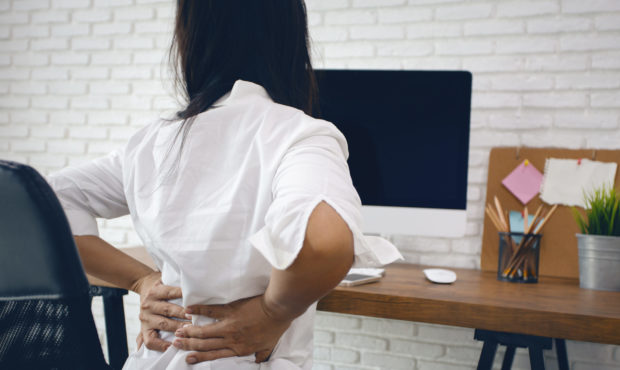Many of us were told as children to stand up straight – but how often do you inadvertently find yourself slouching over your desk, shoulders rounded, head dipped?
Generally speaking, our lives are becoming more and more sedentary – we sit at work, we sit to get to work, we sit to relax after work – which doesn’t help when it comes to keeping our backs strong and healthy.
Poor posture can be associated with problems later in life (although this isn’t the case for everyone and sometimes there are other factors involved).
Physiotherapist Tim Allardyce says if problems aren’t corrected early, people can sometimes end up with “dowager’s posture” or a rounded, forward-flexed upper back.
“Eventually that causes all kinds of problems with mobility, loss of balance, problems walking and mechanical issues with the ribs,” says Allardyce.
He adds that there is some degree of inevitability here (we often naturally become more rounded as we age), but “it can be minimised” and tackling things early often helps.
Generally speaking, there’s lots we can do to help improve our posture day-to-day…
Work your pelvis
If you have a tendency to stick your bottom out, curve your pelvis slightly inward.
Many of us naturally stand with our lower back curved outwards. Orthopaedic spine surgeon Dr Ken Hansraj explains: “At the level of the spine, common sense dictates that the belly becomes more belly-shaped, [this lower curve in the spine is known as lordosis].
“With increased lordosis, the nerves have less space to exit and [are] more likely to be tweaked, causing pain, numbness and weakness. This curve in the spine also puts a strain on nerves in the lower back.”
Move your head slightly backwards
This will straighten your upper spine. “When our posture is poor, we tend to sit or stand with a forward head posture, and that places strain on our neck muscles as they try to support the weight of the head,” says Allardyce.
“If the head is forwards, gravity is exerting greater pressure on our neck muscles, in the same way that it’s harder to lift a kettle with an outstretched arm than closer to your body.”
Roll your shoulders back and down
This is a classic, but slouching shoulders are very common and not good for the shoulders, neck or upper back, Allardyce notes.
“The big problem with slouching is that we may develop an excessive kyphosis – that’s the normal forward curvature in our upper back. If we slouch a lot, this kyphosis can become exaggerated,” he says.
It means we can end up leaning forward more, which places pressure on discs and muscles and can lead to backache, he explains.
Use your core more
It seems we really underestimate how important core strength is when it comes to posture – and we’re not just talking about a six-pack or abs here, rather all the internal core muscles and stabilisers.
“I believe the inner core muscle, called the psoas muscle, is a great indicator of spinal health and has great implications for ageing gracefully,” Hansraj says, adding that posture is an “important mitigation tool” to balance spinal forces most efficiently. In other words, helping balance the load on the spine.
Allardyce says: “Yoga is fantastic for strengthening the core, pelvic floor and encouraging correct breathing. It is good for posture, and strengthening the scapula (shoulder blade) muscles.”
Pilates-based exercises can be very beneficial too.
Watch your ‘text neck’
It seems we’re looking down at our phones far too much and it’s contributing to poor posture and neck pain.
“The more phone and laptop use we do, the more we get into the habit of looking down,” says Allardyce. “To improve your posture, lift your chin, look along the horizon line.”
Try holding your phone higher too, as our necks aren’t designed to support our heads for long in a forward-tilt position.
Sit less and sit better
Hansraj says sitting for prolonged periods can strain your back – but it’s the positioning that can make it even worse. So your posture in a chair is just as important as when standing.
Having both feet flat on the floor is vital, and he advises making sure your back is aligned against the back of the seat, keeping your shoulders straight and avoiding rounding forward. A lumbar support pillow or just a rolled-up jumper behind your lower back will encourage you to stay in a good position too.
Try ‘the dart’
This is a Pilates exercise known for helping to promote good posture. Allardyce says: “Lie on your front. Squeeze your shoulder blades in a V-shape, down and in. Lift your arms behind you.”
“You can make the exercise harder by turning the hands outwards or upwards, so the palms face away from your thighs. You can also lift your head slightly,” he adds.
Always seek advice from a doctor or physiotherapist before beginning any new exercise regime, especially if you have a history of pain or injuries.
